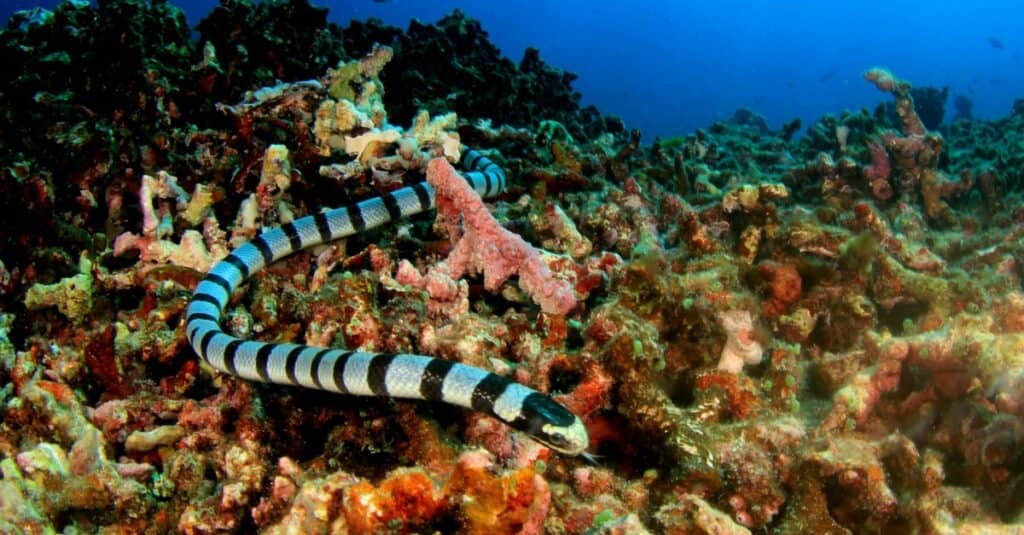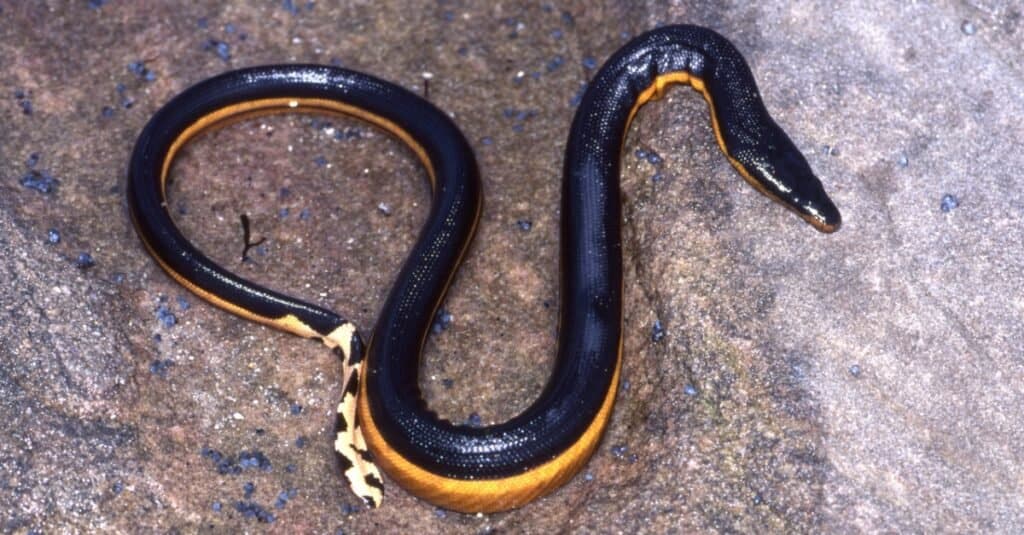Sea snakes often do not have one specific appearance and shared characteristic. The term “sea snake” represents a wide range of snakes under the Elapid family that has adapted to live on land and in marine habitats. Found mainly in warm tropical waters of the Indian Ocean and the Pacific Ocean, all 52 known sea snakes are venomous. Most of these sea snakes are known to have high levels of venom, but only a few species can be fatal. Sea snakes can be highly venomous and dangerous, depending on the species.
While all sea snakes can bite, some species’ venom is only potent enough to cause mild to moderate symptoms ranging from swelling of the bite site to nausea and dizziness. However, some species can be highly lethal, and their bites can result in coma and respiratory collapse. Contrary to popular belief, sea snakes are not aggressive snakes, and they like it better when they are left alone in their habitat. Most sea snake bite reports are often from fishers who may have encountered them from fishing nets or accidentally stepped on water. Sea snakes are venomous, yet their bites are almost painless.
Sea Snake Bites

A single bite from the Belcher’s sea snake can kill a human in less than thirty minutes.
©SaltedLife/Shutterstock.com
Sea snakes may possess venom in their bites, but they do not bite very often. Sea snakes are not aggressive, and they usually won’t initiate an attack. Instead, they will try to avoid human contact as much as possible. Most sea snake bites can only cause mild symptoms. However, some sea snake species are more venomous than others, and some venomous bites can have more severe symptoms than usual.
Although all sea snake species possess venom, not all bites result in envenomation. Some bites are merely a warning for the predator or the perceived adversary to back off. However, if envenomation occurs, the common symptoms from most sea snake bites include minimal swelling and headaches. Sea snake bites are often painless, and victims will only realize they have been bitten when the symptoms start to show after a few minutes or hours.
Sea snakes are typically not aggressive, and they only bite when they are cornered, threatened, or stepped on. Most bite reports are from fishers who have been removing them from fishing nets or people who may have stepped on them accidentally while wading in seawater. Sea snakes bite using their fangs. As venomous snakes, they are equipped with sharp fangs that are not long enough to penetrate through a wetsuit. The bite site often has a tiny pinprick, but it is usually painless. Sea snake bite marks can be as few as one fang mark to as many as 20.
Are Sea Snakes Dangerous to Humans?

The hook-nosed sea snake is responsible for most deaths from sea snake bites.
©Rich Carey/Shutterstock.com
Sea snakes are one of many snakes on the planet that contain venom, and some of them are far more venomous than others. Generally, sea snake bites are not fatal or dangerous to humans. Yet, there are some species of sea snakes you should watch out for. The beaked sea snake or the hook-nosed snake, for instance, is the world’s most venomous snake and is responsible for most deaths from sea snake bites.
Sea snakes are often non-aggressive and would rather swim away when they approach humans. However, when they feel cornered, they may lash out and rely on their last defense mechanism – biting.
Since the sea snake’s bite is usually not that painful, most victims notice that they have been bitten once they are out of the water or a few hours after the bite, when the symptoms start to show. The symptoms of a sea snake bite include:
- Redness and swelling around the bite site
- Headaches
- Dizziness
- Excessive saliva production
- Sweating
- Nausea
- Weakness
- Body aches
- Muscle stiffness
- “Thick tongue” or difficulty speaking or swallowing
- Paralysis (immobility of legs)
- Blurry vision
- Respiratory collapse
Common sea snake bites such as that of sea kraits are rarely fatal. Yet, some species’ bites with more potent venom need to be attended to medically and immediately, for they can lead to death when left untreated. For serious bites, there are also antivenom drugs that can be administered. Most sea snake deaths are caused by leaving the bites medically unattended because of the lack of initial pain and symptoms.
Are Sea Snakes More Dangerous than Land Snakes?

Some species of sea snakes are more venomous than some land snakes.
©Ken Griffiths/Shutterstock.com
All sea snakes are terrestrial snakes that happen to have adapted to marine life. Thus, they often have the same level of venom as other terrestrial snakes. However, a few sea snakes species are more venomous than others and are more venomous than some land snakes. The yellow-bellied sea snake, for instance, ranks as one of the most venomous snakes on the planet. The same goes with the Dubois reef sea snake. The most venomous of them all is the hook-nosed sea snake. This sea snake’s venom is studied to be 100 times more lethal than most snake species.
Out of all the reported incidents of snake bites, 3% of them have led to death. And most of that 3% are caused by a beaked sea snake or a hook-nosed snake. Their venom is estimated to be 4 to 8 times more deadly than a king cobra. Each beaked sea snake’s bite delivers 7.9 to 9.0 mg of venom, and it only takes 1.5mg to kill humans. This means that one drop of their venom can kill about eight humans. That is insanely dangerous!
How to Avoid Sea Snake Bites
Sea snakes are generally not aggressive. Instead, they will try to stay away from humans as much as possible. However, some curious sea snakes can swim towards human divers and swimmers and approach them. All you have to do is stay calm and move slowly in these instances. Sea snakes may think of you as another animal, and if you move slowly, they may eventually swim away. Curious sea snakes can also approach you but will still keep their distance. Never try to come to them first, as they may act in self-defense and bite.
If you’ve ever wondered how sea snakes breathe, you can check our article on how sea snakes breathe.
The photo featured at the top of this post is © Ken Griffiths/Shutterstock.com
Discover the "Monster" Snake 5X Bigger than an Anaconda
Every day A-Z Animals sends out some of the most incredible facts in the world from our free newsletter. Want to discover the 10 most beautiful snakes in the world, a "snake island" where you're never more than 3 feet from danger, or a "monster" snake 5X larger than an anaconda? Then sign up right now and you'll start receiving our daily newsletter absolutely free.
FAQs (Frequently Asked Questions)
Who are the grandmothers studying sea snakes?
“The Fantastic Grandmothers” are a group of snorkelers from Noumea, New Caledonia who found there were far more great sea snakes in the Baie des Citrons than previously thought. They’ve teamed with scientists in an effort to provide citizen scientist-assisted research.
Are there snakes that live on beaches?
While not commonly found living on beaches, some snakes are found on beaches occasionally. There are snakes that live in the dunes and grasses around beaches and some are strong swimmers that live in the ocean.
Thank you for reading! Have some feedback for us? Contact the AZ Animals editorial team.






